Just when we thought we had mastered SEO, AI rewrote the rules. The evolution of search, from direct answers in AI Overviews to conversational chatbots, prompts the question: is link building still relevant?
The answer is clear: link building’s value remains, but its execution and strategic importance are changing. In the AI and Answer Engine Optimization (AEO) era, the focus is shifting from technical signals to broader brand authority and contextual relevance. This article will provide a roadmap to understand this new landscape, helping you adapt your strategies to ensure your brand remains visible, authoritative, and trustworthy.
What Is Link Building?
Link building is the process of attaining links to your website from other websites. Also called “backlinks” or “inbound links,” link building is an essential component of constructing a growth-driven search engine optimization (SEO) strategy, acting as digital votes of confidence from one site to another.
Think of it this way: imagine your website or a specific piece of your content is a groundbreaking research paper. In the academic world, the more often your paper is cited by other reputable scientists or published in prestigious journals, the more authoritative, trustworthy, and influential your research is considered.
Well, in the digital realm, backlinks are those citations. When a high-quality website links to your content, it’s an endorsement; a “digital citation” that signals trust and authority to search engines, including their AI algorithms.
How Links Drove Pre-AI Search Engine Rankings
Before advanced AI and large language models (LLMs) became integrated into search algorithms, backlinks were the ultimate force driving SEO due to Google’s PageRank algorithm.
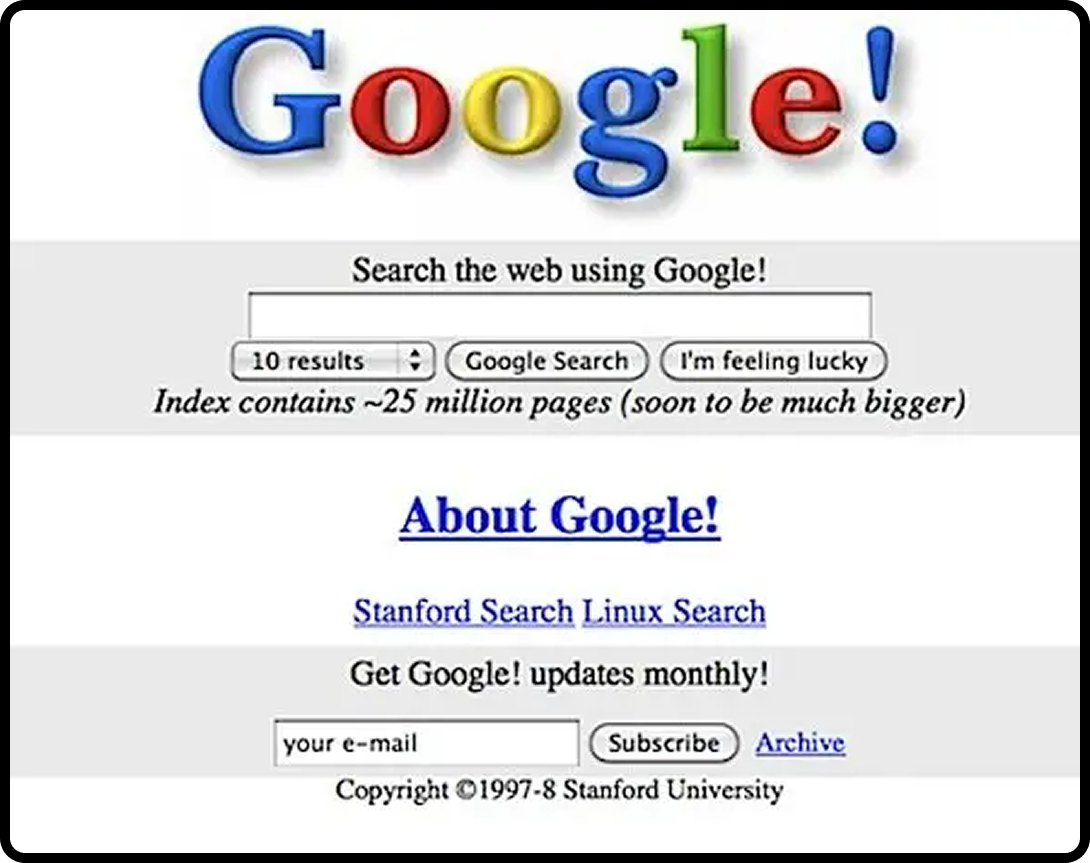
Launched in 1998, PageRank was a trailblazing advancement in search engine algorithms, treating hyperlinks as “votes of confidence” from one web page to another. Before PageRank, search engines primarily used keyword density to rank content. This method was prone to manipulation and often led to irrelevant search results.
Marketers would often “keyword stuff” pages, overloading them with target phrases, making the content unnatural and unhelpful for users, but boosting rankings. This tactic frequently delivered a frustrating search experience by prioritizing the quantity of keywords over content quality or relevance.
As PageRank shifted away from the practice of keyword stuffing, its algorithm started to embrace the idea that a page’s importance and authority could be determined by the quantity and quality of links pointing to it. A link from a highly authoritative and relevant website carries significantly more “weight” or “link equity” than a link from a low-quality, irrelevant site. This innovation allowed Google to identify authoritative content more effectively than prior keyword-density reliant algorithms.
Website owners learned that to rank, they needed to acquire links through:
- Link Building as a Discipline: Early tactics often included reciprocal linking (link exchanges), directory submissions, and later, guest posting and resource page outreach.
- Focus on Digital Authority: The emphasis shifted from stuffing keywords onto pages to building a link profile that signaled authority and relevance to search engines.
- SERP Dominance: Websites with strong PageRank scores would consistently appear at the top of the search engine results pages (SERPs) for relevant queries, driving organic traffic and establishing market leadership.
The Battle Against Spam
As the profound value of backlinks for search rankings became evident, so too did the widespread rise of manipulative “black hat” tactics. This led to a proliferation of spammy links, which artificially inflated a site’s ranking, often through unnatural methods like link farms, hidden links, or keyword over-optimization in anchor text.
Google consistently responded to these abuses with significant algorithm updates. Most notably, the Penguin update was specifically designed to identify and devalue these artificial link schemes. This crucial shift meant that “black hat” tactics not only failed to provide SEO benefit but could actively harm a site’s rankings, leading to penalties. Google’s ongoing battle against such manipulative tactics continues to refine its ability to discern legitimate, earned authority from manufactured signals.
Types of Links & Their Value
Not all links carry the same weight. Recognizing the value of each link type is critical for crafting an effective and sustainable strategy that resonates with modern search algorithms.
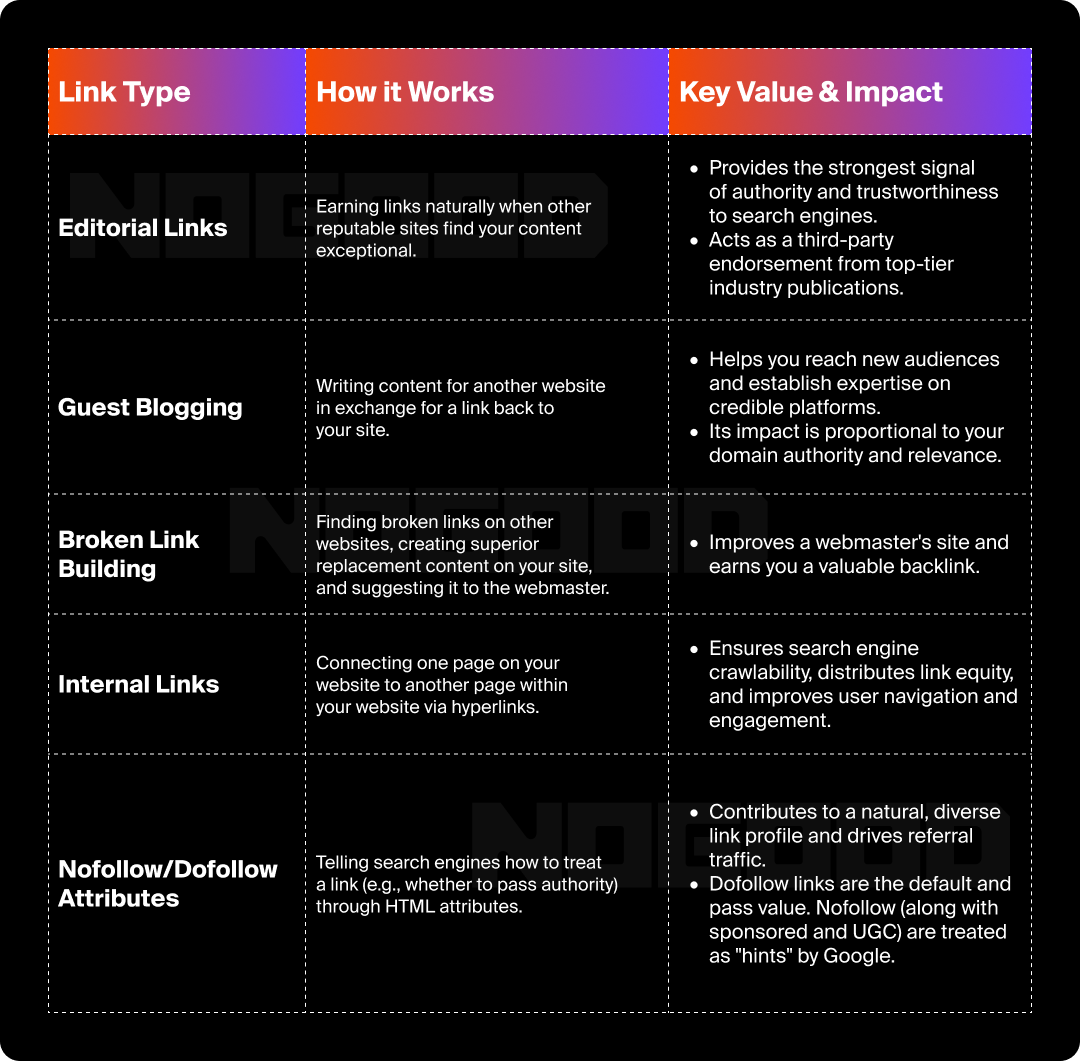
Key Metrics for Link Building
As Google’s algorithms advanced, it eventually stopped publicly displaying PageRank scores. However, the principle of authority still influences search rankings. Many SEO tools now use their own metrics to estimate a website’s authority based on its backlink profile. These include:
- Domain Authority (DA): A score (1-100) developed by Moz that predicts how likely a website is to rank in search engine results, which you compare against competitors. It considers multiple linking root domains, the number of total links, and other factors.
- Page Authority (PA): Also developed by Moz, PA predicts the ranking strength of a single page rather than an entire domain.
- Domain Rating (DR): A score (1-100) developed by Ahrefs that shows the overall strength of a website’s backlink profile.
- Authority Score (AS): A composite metric from Semrush that assesses a domain’s overall quality and influence, considering backlinks, referring domains, organic traffic, and spam factors.
- URL Rating (UR): Also developed by Ahrefs, UR specifically measures the strength of an individual URL’s backlink profile.

While these metrics were not created by Google, they provide benchmarks that allow you to understand the link strength of direct competitors, target websites with high scores for potential link opportunities, and track the growth of your own site’s perceived authority over time.
The AI Revolution in Search
AI enables search engines to comprehend context, anticipate user intent, and deliver relevant results, leading to a more conversational information-seeking experience. As a result of its heightened capabilities, with around 5.6% of desktop traffic going to AI search engines like ChatGPT or Perplexity, more than doubled from a year ago.
AI’s Deeper Understanding of User Intent & Entities
The primary shift in search due to AI lies in its ability to comprehend human language, contextual nuances, and the intricate relationships between different concepts.
Today, search engines powered by Large Language Models (LLMs) decipher:
- User Intent: What is the user trying to achieve with their query? Are they looking for information (informational intent), trying to buy something (transactional intent), or navigating to a specific site (navigational intent)?
- Context: AI analyzes surrounding words, the user’s search history, location, and even the time of day to fully understand a query’s context.
- Entities: AI builds a vast knowledge graph mapping distinct things or concepts (e.g., a brand, a product, a person) and their relationships for comprehensive answers.
The Rise of Generative AI & LLMs
LLMs operate with high level contextual understanding, enabling a multifaceted approach to information retrieval and presentation:
- Information Synthesis & Cross-Referencing: Instead of simply presenting a list of links, LLMs like ChatGPT, Gemini and Copilot crosso dos-reference information from authoritative sources across the web. This synthesis prioritizes accuracy and comprehensiveness from multiple validated points.
- Generative Summarization (AI Overviews): This processing culminates in features like AI Overviews (previously known as Search Generative Experience), which are becoming prominent at the top of Google’s SERPs. In fact, Google’s AI Overview appears in over 50% of all Google searches. These AI summaries provide direct answers to user queries, compiling information with accompanying attribution and links to the source websites.
The “zero-click search” phenomenon, when a user finds the answer to their query on the SERP without needing to click on anything, is now a reality as a user’s query might be fully resolved within the AI Overview or in a conversation with ChatGPT. This shift is crucial for brands because it means that AI will increasingly choose authoritative sources to cite and summarize, moving beyond traditional SERP placement as the primary conversion driver. A new era in search is here, ushering in a discipline that transcends traditional SEO: Answer Engine Optimization (AEO).
Navigating the AI-Transformed SERP
SERPs have evolved, and AI’s increasing integration has reshaped how users find information, demanding new strategies for visibility. While some features like Featured Snippets, People Also Ask, and the Knowledge Graph have existed for years, AI now deeply influences their content selection, presentation, and your opportunity for inclusion:
- AI Overview: This generative summary provides direct answers at the top of Google’s SERPs, often synthesizing information from multiple sources. Therefore, your goal shifts to becoming the cited source, requiring content structured for AI readability and strong H.E.E.A.T. (Helpfulness, Experience, Expertise, Authoritativeness, and Trustworthiness).
- People Also Ask (PAA): This list of FAQs sources answers from highly authoritative websites, often leveraging AI’s understanding of user intent. Optimize your content by directly answering these long-tail queries, using clear H2s and H3s to capture visibility across the user’s research path.
- Knowledge Graph: Google’s repository of facts about entities and their relationships, often appearing as a side panel, is reinforced by AI’s contextual understanding. Ensure verifiable information across all digital touchpoints and utilize structured data markup to explicitly define your entity for AI.
- Videos: Videos are integrated directly into SERPs, sometimes as featured snippets or sources within AI Overviews and chatbots. Invest in informative video content, optimizing it with titles, descriptions, and transcripts.
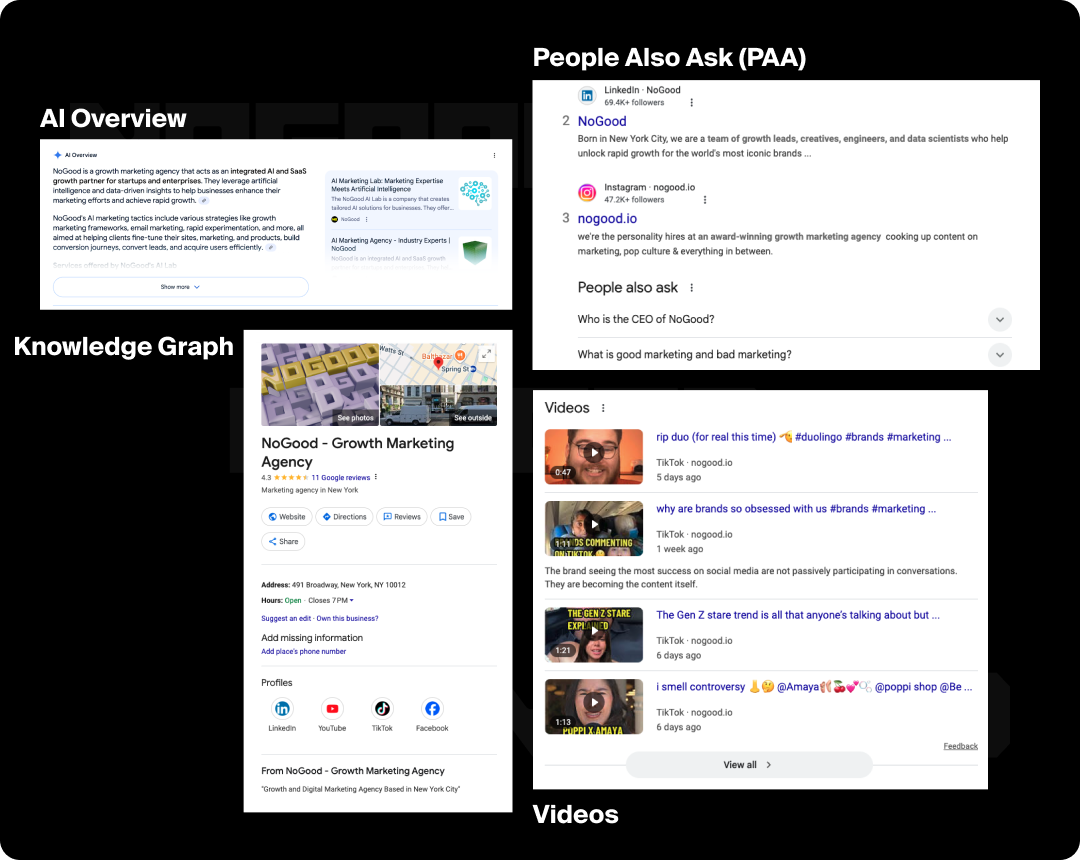
How Links Still Reign: AI’s Evaluation of Digital Authority
Links aren’t just relevant; they’re foundational signals of trustworthiness and authority for AI. AI models are engineered to prioritize credible sources, and their evaluation discerns who to cite.
Beyond Votes of Confidence
Where traditional algorithms focused on domain authority and hyperlinks, AI performs a semantic analysis of the entire linking environment. This demands adaptation:
Semantic Relevance & Topical Proximity
AI understands the true meaning of content. A link from an authoritative source on a semantically similar topic is more valuable than a generic link. For instance, if you’re writing a blog about healthy eating, a link from a reputable health website like MayoClinic is more valuable than a link from a general blog. AI doesn’t just match keywords; it understands the surrounding text, the theme of the linking page, and overall relevance to your topic.
Entity Relationships & Knowledge Graph Reinforcement
In the AI Knowledge Graph, links are essential for establishing your brand’s authority. When an authoritative source links to your brand, AI deepens its understanding of your brand as an established and credible entity within its industry. This “entity-based SEO” solidifies your brand’s authoritative presence in AI’s understanding of the web. For example, if a leading tech publication links to your company’s research on AI ethics, it signals to AI that your brand is a trusted voice in that field.
The End of the Quality Over Quantity Imperative
The age of acquiring spammy links is over. AI’s advanced capabilities make manipulative “black hat” SEO tactics detrimental:
- Sophisticated Pattern Recognition: AI algorithms identify unnatural link patterns, such as sudden spikes from irrelevant domains or anchor text.
- Devaluation, Not Just Ignorance: Poor quality links aren’t just ignored; AI’s design can penalize associated domains, harming your credibility.
- Focus on Natural Acquisition: The emphasis is on earning links through valuable content that merits external endorsement. AI favors authenticity and signals that reflect editorial discretion.
Conversely, ethical, white-hat strategies focused on earning natural endorsements build lasting authority that AI trusts. Nowadays, any short-term gains from manipulative tactics are met with penalties.
Trust & Authority (H.E.E.A.T.)
You may be familiar with the H.E.E.A.T. content framework for SEO and AEO—AI engines use a similar valuation system for backlink profiles. AI relies on H.E.E.A.T. (Helpfulness, Experience, Expertise, Authoritativeness, and Trustworthiness) to determine which sources to cite in its AI Overviews and direct answers. Link building transforms into a direct strategy to build H.E.E.A.T.
- Validating Expertise & Authoritativeness: Links from reputable institutions or experts act as validation of your brand’s and authors’ expertise and authority to AI. This boosts your content’s likelihood of being cited.
- Building Trust Signals: A naturally acquired backlink profile signals trustworthiness to AI. Conversely, a profile laden with manipulative elements makes AI less likely to cite your content, and therefore surface your brand to users.
Links contribute to brand awareness by increasing citations in LLMs and strengthening a brand’s Google Knowledge Graph entity, offering long-term equity even without direct clicks. They also serve as pathways for AI crawlers, influencing content discovery and prioritization for summaries.
Adapting Your Link Building Strategy for the AI Era
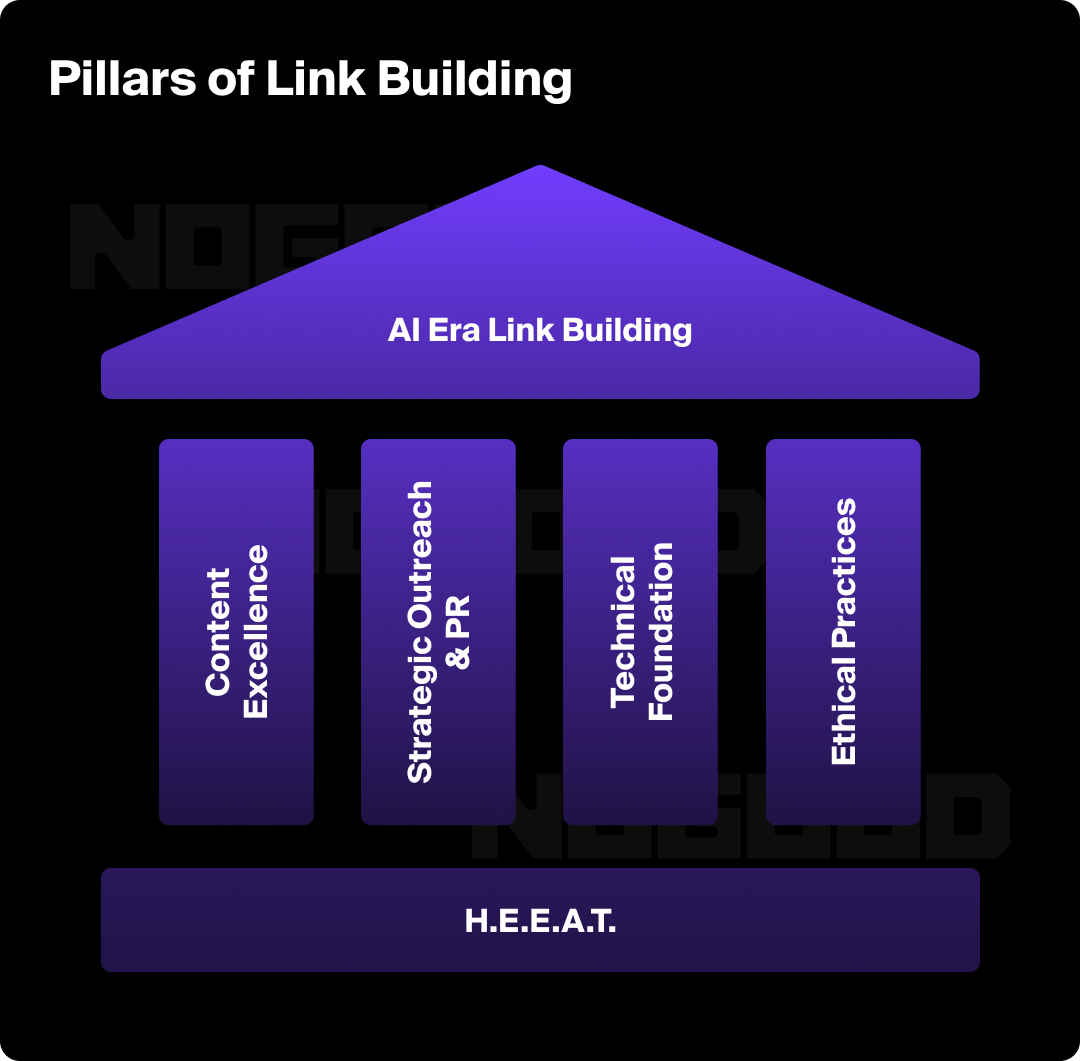
The shift to AI search demands a re-strategized approach to link building, evolving from volume-centric tactics to earning digital endorsements that AI recognizes as signals of authority and relevance. This is where Answer Engine Optimization (AEO) transforms your link building mandate.
Shift from “Link Acquisition” to “Authority & Relevance Acquisition”
The focus on gaining a hyperlink gives way to a broader objective: establishing your brand as the definitive source on a given topic.
- Strategic Focus: Instead of just getting links, aim to be the definitive source on a topic so that AI is compelled to draw answers directly from it.
- Invest in Original Research: Produce unique data and insights that others want to cite and link to.
- Create “Ultimate Guides” & Resource Pages: Develop evergreen assets that serve as direct answers and naturally attract links, allowing AI to understand your authority.
Targeting for AI-Friendly Links
Prioritize signals that AI algorithms value for their semantic understanding and trust assessment.
- Contextual Relevance: Prioritize links from sites that AI deems relevant to your specific entities and topics. For example, if you’re a Fintech company looking to increase organic traffic, you might want to target a website like NerdWallet when building a backlink profile.
- Unlinked Brand Mentions: Monitor for and potentially convert unlinked brand mentions into links, as AI registers unlinked brand mentions as a signal of prominence.
- Visual Assets & Data: Optimize images and data for linking (image linking), as AI processes multimodal content to generate answers.
The Role of Outreach in an AI World
Outreach remains vital, but its focus shifts from mass campaigns to personalized interactions.
- Personalization & Value-Add: Outreach must focus on offering value to the recipient’s audience, positioning your content as an authoritative contribution.
- Strategic Partnerships: Building long-term relationships with brands can lead to guest blog opportunities on high H.E.E.A.T. sites, co-created content, or mutual resource recommendations.
Technical Link Building for AI
Technical link building practices are crucial for ensuring AI can properly interpret and value your content’s authority signals.
- Ensuring Internal Linking Supports Topical Authority: An internal linking structure helps AI understand your site’s hierarchy and signals which pages are most important.
- Regularly Auditing Backlink Profiles: AI’s ability to detect manipulative link schemes means a clean backlink profile is indispensable.
- Using Google Search Console for Performance Monitoring: GSC remains the definitive source for understanding how to optimize best for Google and LLMs. Monitor for manual actions and performance shifts.
The Modern Link Builder
In this evolving digital landscape, link builders become the strategic architects of your brand’s digital authority, with their role expanding to include:
- Deep Content Strategy Partnership: Collaborating directly with content teams to ensure the creation of inherently “linkable” assets able to be cited by AI.
- Advanced Prospect & Context Analysis: Using AI to identify sites with semantic relevance and contextual alignment with your brand’s entities.
- Relationship-Driven Digital PR: Building long-term relationships with authoritative publishers who will endorse your content.
- Proactive Authority Amplification: Strategically convert unlinked brand mentions into link signals and ensure all your digital assets are optimized for multimodal AI consumption.
- Data-Driven Adaptation: Continuously analyzing AI’s interpretation of links and adjusting strategies based on how your content performs in AI Overviews and chatbots like ChatGPT, Gemini, and CoPilot.
Utilizing specialized AI visibility software such as Goodie enhances your marketing team’s capabilities by empowering them to develop content that AI and other authoritative sources trust in order to gain citations.
Investing in such a solution is a critical move for your brand’s future relevance, streamlining the process of earning digital endorsements and serving as a component of AEO strategy.
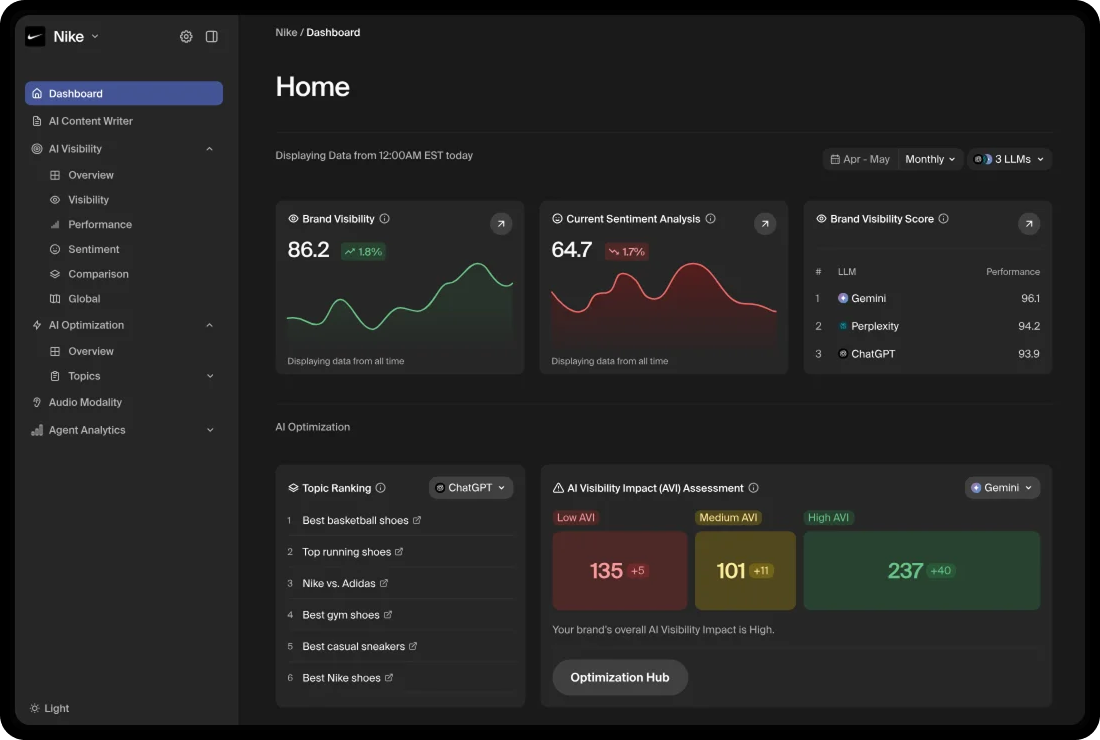
Understanding the Cost of Modern Link Building
Modern link building necessitates a significant financial investment. This is a strategic allocation of resources that contributes to the development of long-term digital authority and brand equity.
- Content as the Cornerstone: The most significant investment will often be in producing AI-citable content such as original research, data studies, and comprehensive guides. This type of content is a magnet for backlinks.
- Expert Labor & Digital PR: Effective link building requires professionals: digital PR specialists, outreach experts, and SEO and AEO strategists. Their expertise in identifying opportunities, crafting pitches, and building relationships represents a sizable labor cost.
- Advanced Tools & Technology: Subscriptions to SEO, content intelligence, and AI-powered analytics platforms can help your team perform competitive analyses, prospect, manage outreach, and monitor performance.
- Strategic Partnerships & Collaborations: Investing in co-marketing initiatives, expert contributions, or sponsored content on authoritative platforms can be a valuable part of the strategy, providing brand exposure and highly relevant links.
Ultimately, the cost of modern link building is an investment in sustainable organic visibility, direct AI citation, and your brand’s enduring authority.
The Future of Authority
As AI continues to evolve, the definition of “authority” is expanding. Moving forward, the assessment of your brand’s influence by AI will involve a broader spectrum of signals, requiring a focus on traditional backlink metrics.
Anticipating Future AI Signals
While direct hyperlinks will remain a core component, AI’s ability to interpret data patterns suggests the emergence of new “link-like” signals:
Verified Real-World Impact:
AI could evaluate your brand’s influence beyond its website. This could involve assessing:
- Mentions in Reputable News & Academic Papers: AI’s capacity to read and understand text from non-web-indexed sources could elevate these mentions into authority signals, even without direct hyperlinks.
- Influence in Physical World Events: AI could process individuals’ participation in industry conferences or community initiatives through their digital footprints.
- Blockchain-Verified Credentials: Emerging technologies like blockchain could provide new forms of trust signals if your brand’s expertise or product claims are tied to verifiable digital credentials.
User Engagement Across Platforms as a Proxy for Value:
The quality of traffic and how users engage with your content across various platforms will become critical. User engagement acts as validation of your content’s quality and value to AI.
Building an AI-Fluent Marketing Organization
The changing landscape demands an evolved skillset within marketing teams:
- Fostering Cross-Functional Collaboration: Silos between SEO, content, PR, and data science teams must dissolve. Build cross-functional teams where expertise is shared, and strategies align to maximize content’s potential for AI citation and link acquisition.
- Cultivating AI Literacy Across Teams: It’s no longer enough for a few specialists to understand AI. Prioritize training your entire marketing organization on how AI processes information, what signals it values, and how these impact content strategy and performance.
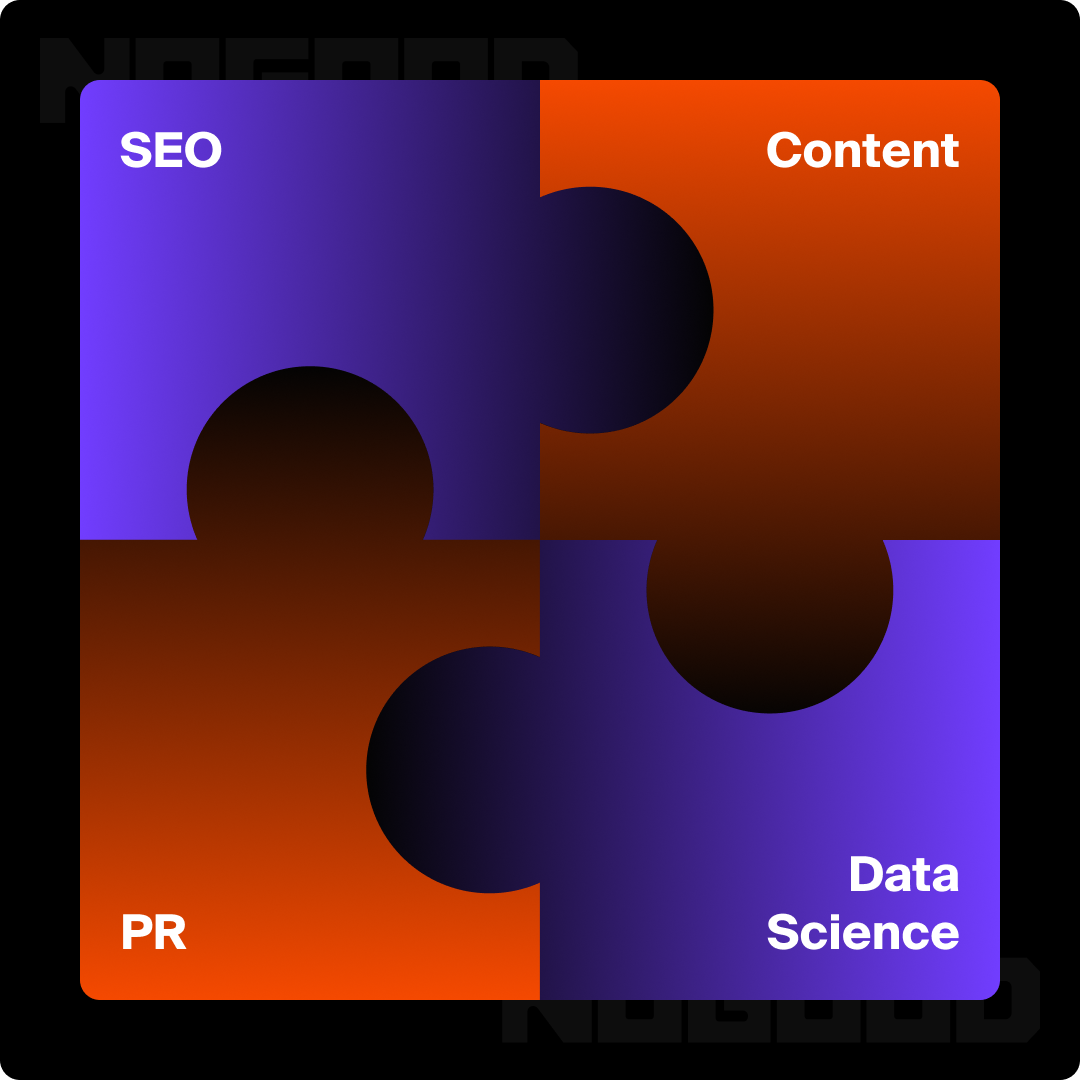
Conclusion: Is Link Building Still Relevant?
The key takeaways are clear: success hinges on focusing on contextual relevance, building H-E-E-A-T, creating AI-citable content, and adopting a holistic approach to digital authority. This means integrating link building with broader content and PR strategies. Adaptation and an understanding of AI’s capabilities will be the differentiator for future marketing success, ensuring brand prominence in the search landscape.






